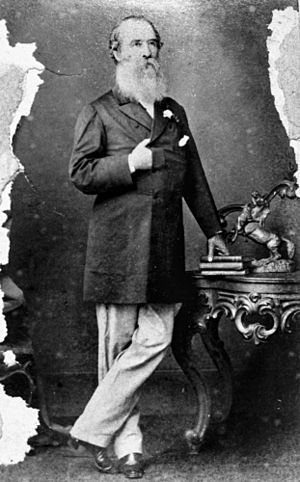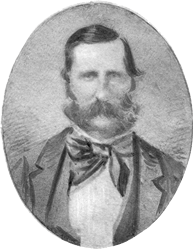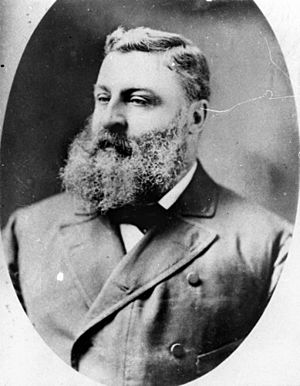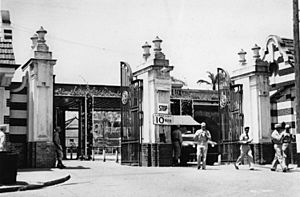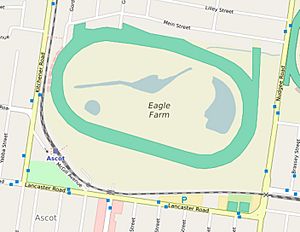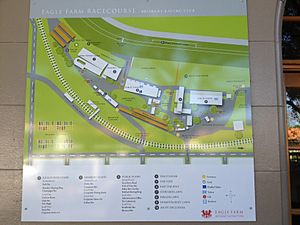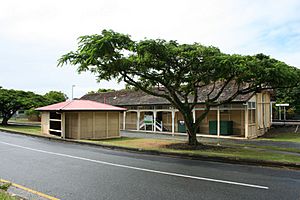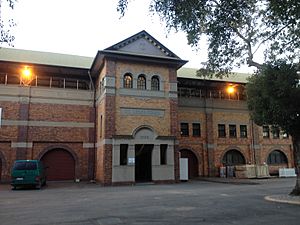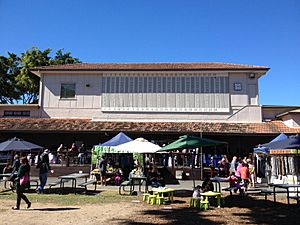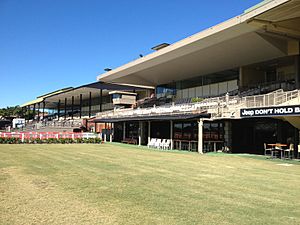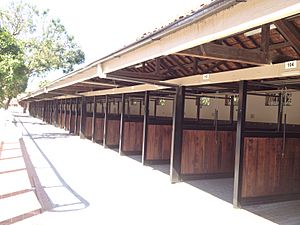Eagle Farm Racecourse and Ascot railway station facts for kids
Quick facts for kids Eagle Farm Racecourse and Ascot Railway Station |
|
|---|---|
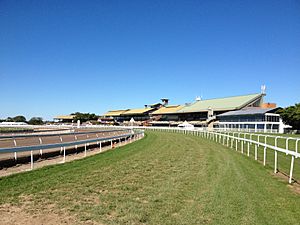
Eagle Farm Racecourse, 2013
|
|
| Location | 230 Lancaster Road, Ascot, City of Brisbane, Queensland, Australia |
| Built | 1863 onwards |
| Official name: Eagle Farm Racecourse and Ascot Racecourse, Brisbane Racecourse, Racecourse Railway Station | |
| Type | state heritage (built) |
| Designated | 25 June 2004 |
| Reference no. | 602195 |
| Significant period | 1882–1958 (fabric) 1863–ongoing (social) 1865, 1882, 1885, 1912, 1941–1946 (historical) |
| Significant components | stables, totalisator, bridge – foot/pedestrian, toilet block/earth closet/water closet, residential accommodation – housing, trees/plantings, garden – ornamental/flower, grandstand, bandstand/rotunda, railway siding, wall/s – retaining, greenhouse, refreshment booth, tree groups – avenue of, gate – entrance, tunnel – pedestrian, office/administration building, railway station, signal box/signal cabin/switch house/mechanical points (rail), ticket box/office |
| Lua error in Module:Location_map at line 420: attempt to index field 'wikibase' (a nil value). | |
The Eagle Farm Racecourse and Ascot Railway Station are important historical sites in Ascot, Brisbane, Australia. This special place includes a famous racecourse and a railway station. It has been around since 1863 and is known for its horse racing events. The racecourse is also called Ascot Racecourse or Brisbane Racecourse. The railway station was once known as Racecourse railway station. Both were added to the Queensland Heritage Register on June 25, 2004, because of their historical importance.
Contents
A Look Back: History of the Racecourse
The Eagle Farm Racecourse started in 1863. It quickly became one of Queensland's top places for horse racing. Over the years, many new parts were added. These included the Pinkenba railway line in 1882. New stands like the Paddock Stand (1889) and St Leger Stand (1913) were built. A building for betting, called the Totalisator Building, also opened in 1913. The Ascot railway station opened in September 1882. It helped bring many people to the races.
Early Days of Horse Racing
Horse racing was one of the first sports in Queensland. The first races in Brisbane happened in 1843. An early racecourse was at New Farm in 1846. But the Eagle Farm Racecourse soon became the main spot.
In 1863, a large area of land was set aside for the racecourse. It was called the "Brisbane Racecourse." The land was given to a group of trustees. These included important people like Maurice Charles O'Connell, John Frederick McDougall, and George Harris. They were all part of the Queensland Turf Club.
The first big race meeting at Eagle Farm was in August 1865. About 2000 people came to watch. The area was still quite wild and forested back then.
Growing Popularity of Racing
The Queensland Turf Club (QTC) became very important in racing. In 1875, a law made them the main authority. They even sold some land to pay off debts. The racecourse was also used for other sports. People played cricket and polo there.
By the 1880s, horse racing became much more popular. The QTC created new rules for racing. They also started publishing "The Queensland Racing Calendar" in 1886. This helped organize races across the colony.
Many racing clubs started up in Brisbane. The QTC held big events several times a year. Another club, the Tattersall's Club, rented the Eagle Farm course for its races. Their first meeting there was in December 1884.
Getting to the Races: Transport Changes
In the early days, people traveled to the races by horse or buggy. Some even came by a small boat. A big change happened in 1882. A railway line was extended from Eagle Junction to Ascot. This made it much easier for people to get to the racecourse.
The railway station was first called Racecourse. In 1897, its name changed to Ascot. This was named after the famous Ascot Racecourse in England. The line was also extended to Pinkenba that same year. An electric tram line also reached Racecourse Road in 1899. This gave people even more ways to travel.
Racecourse Layout and Social Life
The racecourse was set up to show different social groups. People paid different amounts to enter certain areas. Members had their own special stand. The "outer" area in the middle of the track was popular with working-class people. It had lots of entertainment like boxing tents and side shows.
A small riot happened in 1887 during a race. This showed how different groups felt about the races. The QTC later made changes to how races started. They moved from using a flag to rope barriers and then mobile gates.
New Buildings and Improvements
In 1889, a new grandstand called the Paddock Stand was built. Stables and sheds were also added. The 1893 economic downturn affected racing for a while. But improvements continued into the early 1900s.
In 1912, Queensland agreed to new "Australian Rules of Racing." This helped racing become more organized. Many new buildings were constructed around this time:
- A totalisator building (for betting) in 1913.
- A new St Leger Stand in 1913.
- Beautiful entrance gates in 1913.
- Ticket boxes in 1914.
- New toilets in 1914.
- A bandstand in 1916.
Railway facilities also improved. A bridge over the railway line was finished in 1911. A new siding was built in 1912 to store trains. A second railway station building opened in 1914. This building was made of pre-cast concrete. It is one of the oldest concrete railway stations still in use today.
World War II and Beyond
During World War II, the racecourse was used by the military. From 1941 to 1946, it was called Camp Ascot. Thousands of American soldiers stayed there. They built "igloo" stores for supplies. Racing returned to Eagle Farm in May 1946.
In the 1950s, the totalisator building was made bigger. The John Power Stand was built in 1958. It was named after Dr John Power, a long-time president of the QTC. The club celebrated its 100th birthday in 1963. By then, Eagle Farm was one of Australia's best racecourses.
Since 1963, more changes have happened. A new training track and a horse swimming pool were added in 1969. The track was extended in 1990. Older buildings like the Totalisator building were restored. New dams and water tanks were installed to help with droughts.
Modern Changes and Future Plans
The Queensland Turf Club (QTC) merged with the Brisbane Turf Club in 2008. They formed the Brisbane Racing Club. This was done to make sure racing at Eagle Farm and Doomben Racecourse would continue to be great.
A "Master Plan" was announced in 2009. It aimed to create world-class racing facilities. This plan included new stables and green spaces for the community. Today, Eagle Farm Racecourse is still a top racing venue in Australia.
Ascot Railway Station's Unique Signals
Ascot railway station is special because it still uses old-fashioned semaphore signalling. It also has a mechanically interlocked signal cabin. This type of system was once common but is now very rare. It is one of only a few such systems left in Queensland.
Exploring the Racecourse: What You'll See
Eagle Farm Racecourse is a large, flat area in Ascot. It is surrounded by roads and houses. The railway line runs along its edges. Ascot railway station is at one corner of the site.
Ascot Railway Station Buildings
The station has two main buildings. One is older, built in the 1880s, and made of timber. The other was built in 1914. It is made of pre-cast concrete with pretty timber decorations. Both buildings have gable roofs with large overhangs. A timber bridge for people crosses the railway line near the station.
Entrance Gates and Ticket Offices
The main entrance to the racecourse is on Lancaster Road. It has beautiful wrought iron gates and ticket offices from 1913. These buildings have brick walls and terracotta tiled roofs. Beyond the gates, a subway goes under the railway line. This leads to more ticket offices and gardens.
Public Racecourse Area
The main public area of the racecourse is inside the railway line. It has several grandstands and other buildings. The race track itself takes up most of the space. Stables are located to the west and east of the stands.
St Leger Spectator's Stand
The St Leger Stand is the easternmost grandstand. It was built in 1913 and extended in 1938. It has brick walls and tiered seating facing the track. The roof is supported by a mix of cast iron and timber. Toilets and refreshment rooms are underneath the stand.
Totalisator Building and Paddock Stand
Next to the St Leger Stand are the Totalisator (or Tote) Building and the Paddock Stand. The Tote Building, built in 1913, is where people place bets. The Paddock Stand is similar to the St Leger. It has a large, arched roof and decorative cast iron details.
Members' Stand and John Power Stand
Further west is the three-story Members' Stand from 1925. It has many original timber features. Connected to it is the John Power Stand, built in the 1950s. This stand is made of reinforced concrete. Its roof is an open viewing area with tiered seating. Both stands look out over the parade ring where horses are shown before races.
Other Buildings and Stables
Around the grandstands are many smaller buildings. These include ticket booths, public toilets, and refreshment stands. There are also timber stables for race day. These stable buildings are simple, partly open structures. They have gable roofs and timber walls.
The racecourse grounds are like a park. They have well-kept gardens, many trees, and flower beds. These green spaces make the whole area beautiful.
Why It's a Heritage Site
Eagle Farm Racecourse and Ascot railway station are important heritage sites for several reasons:
- Queensland's History: They show how horse racing grew into a major sport and industry in Queensland since the 1860s. The railway line built just for the racecourse shows how important racing was early on.
- Rare Features: Ascot railway station is special because it still has old semaphore signals and a mechanical signal cabin. This is very rare in Brisbane. It is also the oldest working pre-cast concrete railway station.
- Typical Racecourse Features: The site is a great example of a large city racecourse. It has all the main parts: the track, stables, grandstands, betting areas, and other buildings.
- Famous Architects: Many well-known Queensland architects designed buildings here. Their work shows different styles from different times.
- Beautiful Design: The racecourse is beautiful with its grandstands, entrance gates, and landscaped gardens. The main entrance gates are a local landmark.
- Community Connection: The racecourse has a strong connection with the community. For over 130 years, people have come here for fun, social events, and to enjoy horse racing.
- Queensland Turf Club: The site is closely linked to the Queensland Turf Club (now Brisbane Racing Club). This club played a big role in developing horse racing in Queensland.


